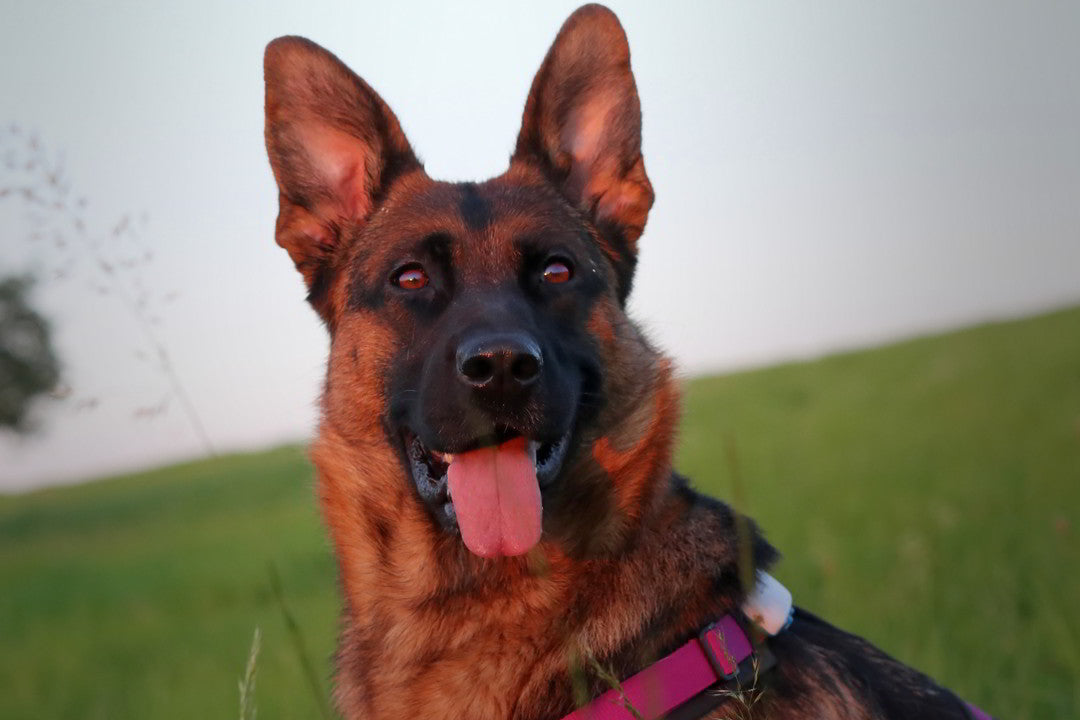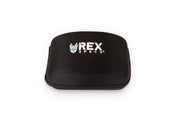What do dogs see?
You probably already know that dogs see the world very differently than humans. If you dig through different sources, you'll find commonly cited facts like "dogs have a visual acuity of 20/75" (compared to our standard for good human vision of 20/20) or "dogs have dichromatic vision" (which is similar to red-green colorblindness in humans). But (excuse the pun) we may not see the whole picture. And while it's difficult to compare apples to oranges, our own vision is the only way we know how to see. We'll give you a little insight into the differences in dog and human vision and explain why your dog sees things differently and how he sees them. You'll get answers to the question "What colors do dogs see?" and "How do dogs see their environment?"
Small note: we will make some generalizations in this text and simplify many facts in order to keep this article short.
THE PHYSICAL DIFFERENCES BETWEEN THE VISUAL SYSTEM OF DOGS AND HUMANS
The visual systems of humans and dogs consist of the same core components.
- Two eyes: for absorbing information
- A central nervous system: to interpret this information
Although there are seemingly endless differences between the central nervous systems of humans and dogs, many of the differences between dog and human vision can be traced back to differences in the eyes.
Dog eyes and human eyes are made up of the same components and building blocks. They both have corneas, lenses, retinas, optic nerves, and a few other things we won't get into. The cornea and lenses work like a camera, letting in an image in the form of light. This image is read by the retina and sent to the central nervous system via the ganglion cells (which make up the optic nerve) for interpretation. Think of the cornea and lens like the shutter and the retina like the image sensor (or film, in analog cameras) of a camera.
THE RETINA
If you were to look through a dog's eyes, some of the biggest differences you would notice would be related to the retina . The retina is made up of three types of photoreceptors: rod opsins, cone opsins, and ganglion cells. Both the rods and cones absorb photons (particles of light) and pass information about that light through the ganglion cells.
- The rod opsins are usually located in the periphery, interpret light intensities, detect movement, have low spatial acuity and are responsible for vision in low light.
- The cone opsins process colors and details and are most active in environments with stronger light.
- Ganglion cells receive the signals from the cones and rods and transmit the image information to the brain, where the image is assembled.
Most animals have some combination of rods and cones in their retinas, but the number of rods and cones varies, with extremes at either end. If an animal has few or no rods, it can probably only see in daylight, while an animal lacking cones cannot see colors. Dogs have about one cone for every 20 rods, meaning their eyes have evolved to prefer features like light and motion over details like color. A study of police dogs showed that the dogs could detect a moving object 810 to 900 meters away, but this detection distance decreased to 585 meters when the object was not moving.
HOW FAR CAN DOGS SEE?
Dogs' eyes are very good at detecting movement at a distance, but have difficulty detecting stationary objects at the same distance. They can detect a moving object up to 900 meters away, but only 585 meters away if the object is still. When it comes to detail, most dog breeds need to be up to 20 meters away from an object to see it in the same level of detail as humans can at 75 meters away.

The left part of the image shows the dog's reduced level of detail (without taking into account other visual factors such as color and binocular vision). Note that the image is stationary. Any movement of the deer would be registered more accurately by the dog's eyes than a human would.
Unlike dogs, humans (and all primates) have a cluster of cones in their retina called the fovea. What do you get when you group these detail-oriented photoreceptors together? Increased attention to detail, including color. Dogs don't have foveal, or central, vision, but they do have a visual band that replaces some visual acuity but doesn't reach the level of central vision in humans.
CAN DOGS SEE IN THE DARK?
The tapetum lucidum allows dogs to detect movement in the dark much better than humans. Because human eyes are generally better at detecting details than dogs', humans can also detect details better in dim light.
In fact, humans are so tuned to detail-oriented vision that they actually see better in low light, being able to detect objects three times the distance better than dogs. It's important to note, however, that these objects are stationary. When motion is taken into account, the rod population of the dog's eye far outperformes the human eye in the dark. In fact, dogs (and many other vertebrates) have a special formation in their eyes called the tapetum lucidum that reflects light back across the photoreceptors, giving them a second chance to capture an image . Because dogs' photoreceptors are excellent at detecting motion, this second chance to capture light is like amplification, allowing dogs to detect motion in the dark exponentially better. Because it's reflective, the tapetum lucidum is also responsible for dogs' eyes appearing to glow in the dark.
WHAT COLORS CAN DOGS SEE?
Dogs can only see shades of blue, yellow and gray.

Another difference between humans and dogs in detail recognition statistics is the cone types. Humans have three types of cones that absorb three different wavelengths (or colors) of light: red, green, and blue . This allows us to see a spectrum of light that includes red, orange, yellow, green, blue, indigo, violet, and shades of gray. Dogs, on the other hand, have only two types of cones, blue and yellow, which allow them to see only blue, yellow, and shades of gray.
As the cones and rods detect color, light, and motion, they pass this information on to the ganglion cells, which then relay all image information to the brain. Dogs have far fewer ganglion cells than humans (about 170,000 in dogs and 1,200,000 in humans) and therefore can relay less information. Combined with the smaller number of cones (the detail-oriented photoreceptors), this is like a lower-resolution digital image being relayed to the brain—one where, if you stretch it, you can see the coarse pixels. Yes, you can make out what it is, but it doesn't have the level of detail of a higher-resolution image.
Veterinary ophthalmologist, founder of the Animal Eye Center and founding investor of Rex Specs, Dr. Steven Roberts DVM, DACVO, explains: "In dogs, four cones typically send information to a ganglion cell. From the perspective of the ganglion cell, it doesn't matter which of the four photoreceptors sends the information, it always responds the same. Therefore, humans have at least four times the visual resolution of a dog."
WHAT IS A DOG'S VISUAL ACUITY?
Dogs see 20-40% less detail than humans in both bright and dim light. Because of the higher rod-to-cone ratio in dogs' eyes, they are more tuned to perceive movement with their eyes than details. If you were to see an image through a dog's eyes, it might look like a low-resolution digital image that has been stretched.
THE LENSES
While the rods and cones absorb light, it is the lens that determines how the light converges on the retina. When light passes through the lens at the front of the eye, it directs the light onto the retina at the back of the eye. The point where the light hits the eye is called the focal point. To ensure proper vision, the distance between the lens and the focal point must be very precise. If it is too far forward or too far back, the image transmitted through the lens will appear blurry (like an out-of-focus camera). When something occurs in the human eye, such as an elongated eye, the focal point is too far forward, so things further away appear blurry. This is commonly referred to as nearsightedness.
So what does this have to do with dogs? Dogs' eyes are shaped differently than ours, and their lenses focus light differently on the retina. And just as an elongated eye (nearsightedness) in humans limits the range of sharp vision, all dogs (compared to healthy human eyes) have a limited range of distances that their eyes can focus on. In fact, most dogs find objects closer than 25-45 cm blurry.
HOW DO DOGS SEE THINGS CLOSE TO THEIR FACE?
Things like toys held close to a dog's face or even scratches on the lens of a pair of glasses will appear blurry to a dog at a distance of less than six inches.
HOW CAN WE SEE WHAT DOG EYES SEE?
Knowing that dogs see fewer details and colors and have a limited field of vision helps us interpret what dogs' eyes might look like when looking at a stationary object . The Dog Vision Image Processing Tool helps us estimate how dogs see the stationary world, but we don't have a tool to help us understand how dogs see motion.

Dogs are unable to see red and replace green tones with more yellow, as their vision is limited to blue, yellow, and gray. Finding a red toy in a green field is therefore almost just a matter of nose work for your dog.
WHAT HAPPENS OUTSIDE THE DOG'S EYES
Most of the differences between what dogs see and what humans see are the result of physiological differences in our eyes. But there are also differences that we can see every day.
DOGS HAVE A DIFFERENT PERSPECTIVE THAN WE DO
We know that dogs see differently, simply because they are smaller than humans, without looking at their brains. Their eyes are, on average, half a meter below ours and look down at many things we look down at. Dr. Roberts suggests, "Try looking at the world from 6 to 24 centimeters above the ground to understand the difference."
BINOCULAR VISION
Simply put, binocular vision is the use of two eyes. With two eyes (in both humans and dogs), we can perceive three dimensions. And when two eyes are close enough together and the brain is able to process and stitch together the two overlapping images from each eye, we have an unobstructed field of vision. In humans, this field of vision is about 180 degrees . Dogs' eyes are also positioned differently on the sides of the head, and this position can vary greatly from breed to breed. In some dogs (usually with longer noses), the eyes are positioned more to the sides of the head, giving a field of vision of about 290 degrees, while other dogs with shorter noses and eyes further forward have a field of vision of about 220 degrees .
HOW DOES PROTECTIVE GLASSES AFFECT DOGS’ VISION?
Because of their larger field of vision, dogs need more room to see to the sides than humans. For this reason, when correctly sizing your dog goggles, we place great emphasis on ensuring there's enough space between the frame and your dog's eyes.
But a dog's eye spacing isn't better in every way. Dr. Roberts explains: "Dogs have a wider field of vision (220 degrees), but a narrower binocular vision zone. Therefore, it's fair to say that a dog's 3D vision is significantly less than that of a human.

DO DOGS SEE IN 3D?
Dogs see in 3D, but due to their narrower binocular field of vision, their 3D perception is limited or less defined.
WHAT DO DOGS SEE BETTER THAN US HUMANS?
As you may have noticed, dogs don't see everything we see, but in some situations they see more. While the numbers and image processing programs do a lot to help us see what the dogs see, we need to imagine what it would be like to see motion better. One way to understand what it's like to have more rods in your retina is to look at the night sky. Have you ever noticed a faint star from the periphery, but when you look directly at it, the star disappears? That's because we humans have more rods in the periphery of our retinas that can detect that faint light in the sky. That's just a small glimpse of what it's like to see like a dog.
*Translation Original Blog Post Rex Specs





